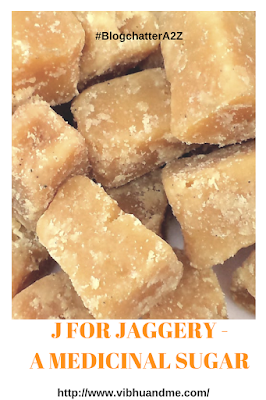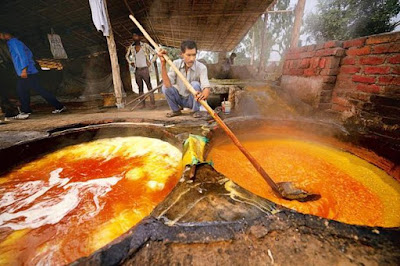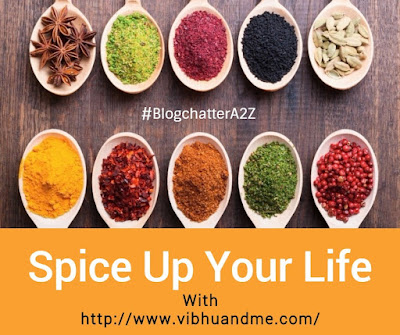 Have you seen that old Amitabh Bachchan and Nutan movie "Saudagar"? Saudagar is a 1973 Bollywood drama film and is one of my all-time favorite flicks. The movie is based on the Bengali story, Ras, by Narendranath Mitra. At one hand where the movie has a few melodious songs, there is one more thing that makes this movie unique. The movie depicts a real-life conflict where a small profession drives the whole film. In the movie, Amitabh Bachchan plays the role of a Gur (Jaggery) seller. He cheats his first wife (Nutan) but his bad business after his second marriage makes him realize his mistake. This film shows the whole process of making date palm jaggery as its integral narration. It is simply commendable how something as small as Gur making is mixed with portrayal of a touching story.
Have you seen that old Amitabh Bachchan and Nutan movie "Saudagar"? Saudagar is a 1973 Bollywood drama film and is one of my all-time favorite flicks. The movie is based on the Bengali story, Ras, by Narendranath Mitra. At one hand where the movie has a few melodious songs, there is one more thing that makes this movie unique. The movie depicts a real-life conflict where a small profession drives the whole film. In the movie, Amitabh Bachchan plays the role of a Gur (Jaggery) seller. He cheats his first wife (Nutan) but his bad business after his second marriage makes him realize his mistake. This film shows the whole process of making date palm jaggery as its integral narration. It is simply commendable how something as small as Gur making is mixed with portrayal of a touching story.I always feel that, although the movie has many lead actors, Gur is the real hero of the movie. Gud forces Moti to marry an older woman, Mahjubhi, who is skilled in making Gur. Moti's Gur becomes famous in the market and soon he collects a good amount of money to marry his real love, a younger beautiful village girl. Moti gives divorce to Mahjubhi and re-marry the village girl. However, the village girl's poor Gur making skills eventually flops Moti's Gur selling business. He realizes his folly when his life begins to fall apart. If you have not seen this movie yet, please watch it legendary drama. And with this plot, today's topic is Jaggery.
J For Jaggery
 |
| Traditional Gur Making (Credit - Google Image search) |
Gur is made from Sugarcane. The process follows only three steps to prepare it. Extraction, clarification, and concentration. Extraction means sugarcanes are pressed through machines in order to extract all the juice. Then it is stored in big containers to settle down. This also makes impurities to sit down at the bottom of the container. The juice is then strained to get a clear liquid. Finally, it is placed in huge flat-bottomed pans and boiled for hours. During this boiling, the juice is stirred continuously. While stirring, remaining impurities also get skimmed from the boiling juice. After hours of stirring, finally, a dough-like thick paste remains in the container. This paste is then transferred into moulds or in a flat container where after cooling it gets hard and this final product is called Jaggery or Gur.
Gur made Laddoos and Chutney is very much liked in my family. Even a Puja happens during winters in which it is a custom to make Gur laddoos. We make different variations of Gur laddoos like Gur with puffed rice, Gur with sesame (Til), Gur with whole gram (Chana) and Gur with peanuts. Especially in winters, Indian people make a routine to have Gur in one or the other way. Some take Milk with Gur. Some enjoy winter delicacies like Gur Chikky and Gazaks. And some like my family prefer having Gur, dry ginger and dry fruit laddoos. Other than sugarcane, Gur is also made from date palm and this variation of Gur is very famous in Bengal.
History of Jaggery
As per book Feasts And Fasts: A History Of Food In India, early Sanskrit texts has many references to Ikshu which is sugar cane only. Even Kautilya in his Arthashastra (around 300 BC) mentioned a wide range of sugar-cane products, including gur, phanita (thickened sugar cane juice, called raab), khand (sugar crystals), matsyandika (larger or whiter sugar crystals) and sharkara. This clearly says that Jaggery is being made since very early days of Indian culture. However, the first clear mention of the use of Jaggery as a natural sweeter is found in 1631. The word Jaggery comes from Portuguese word jágara which means what Sharkara means in Sanskrit, Sweet. It is also believed that sugarcane was the first thing that Gautama Buddha ate after attaining enlightenment. Legend says that two travelers offered him sugarcane after he had been starving for many days and he, in turn, made them his first disciples.
My mother says in colonial India, Gur was the choice of poor people as it was cheaper and healthier. Not everyone that time had access to the refined sugar, so most of the Indian houses used Jaggery in both sweet and savory dishes. A pinch of jaggery added to sambar, dal, and other curries used to balance the spicy, salty and sour components. In my village, Gur making used to be a festival in itself. During November - January, sugar cane juice was traditionally boiled in every other house and in place of using any sort of moulds, roundels of Gur were made. A family making Gur used to invite the known ones to have the freshly made Gur which was a symbolic love and care.
Ayurvedic Benefits of Jaggery
Jaggery is a wholesome diet. In Ayurveda, it is considered "warm and smoky". Jaggery has been used as a sweetener in Ayurvedic Medicine for 3000 years. It is often called medicinal sugar and possesses nutritive properties in abundance. Ancient Ayurvedic scripture, Srushut Samhita states that jaggery purifies the blood, prevents rheumatic afflictions and bile disorders. Magnesium found in jaggery strengthens the nervous system. Also, potassium present in jaggery provides the acid balance in the cells and combats acids and acetones. The micronutrients present in jaggery have antitoxic and anticarcinogenic properties.
- Detoxes Liver
- Purify Blood
- Boost Immunity
- Eases Menstrual Pain
- Prevents Anemia
- Boosts intestinal health
- Controls blood pressure
- Relieves joint pains
- Good source of energy
- Relieves constipation
- Best for respiratory issues.
- Helps in Migraine
Dadi Maa Ka Nuskha
Mix 1 glass of water, little jaggery, few drops of lemon juice and add Black Salt into this mix. Stir and have it as a refreshment drink. This is world's most beneficial energy drink.
How to buyJaggery is available in the market mainly in three forms namely solid jaggery, liquid jaggery and granular jaggery. Your nearby store would for sure have solid jaggery. Don't consider it as a winter food. Little gur after dinner is assumed very good for digestion and overall immune system.
(I am taking part in #BlogchatterA2Z and today’s letter is 'J'.)
You can read my other #BlogchatterA2Z posts here :
- A For Alkanet Root - A Magical Spice
- B For Black Salt - A Digestive Stimulant
- C For Cinnamon - God of Spices
- D for Dried Ginger - A More Beneficial Form of Ginger
- E For Edible Silver and Gold Foils
- F For Fennel Seeds - More Than A Mouth Freshener
- G for Green Cardamom - The Queen of Spices
- H For Holy Basil - The King of Herb
- I For Indian Gooseberry - A Super food











I didn't know how Gud is made...but we often use it in our kitchen for my kid, as a healhier replacement for sugar
ReplyDeleteWe have something similar in our Mexican groceries — pioncillo. https://en.wikipedia.org/wiki/Panela
ReplyDeleteMost of the spices are known and add value to food, but Jaggery and it's large uses made me select this post from rest to read.
ReplyDeleteCheers
Meenalsonal
www.auraofthoughts.com